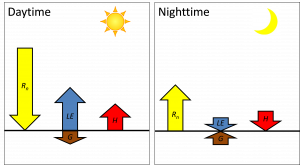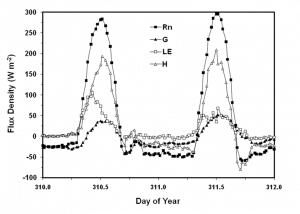12.4 Surface Energy Balance
Having defined net radiation, we can now write the surface energy balance equation:
![]()
(Eq. 12-4)
where LE is the latent heat flux, H is the sensible heat flux, and G is the soil heat flux. The fluxes are commonly expressed in W m-2.
By convention, net radiation is defined as positive towards the surface, while all the other terms are defined as positive away from the surface. During the daytime, net radiation is typically towards the surface, and the other fluxes are away from the surface (Fig. 12‑5). In the nighttime, the fluxes are in the opposite directions. The latent heat flux is typically near 0 during the night, although negative values, indicating condensation, are possible.
The latent heat flux (LE) is the energy that is absorbed by water at the Earth’s surface during evaporation or transpiration apart from any change in temperature. It is a flux or transfer of energy because we assume the resulting water vapor is transported away from the surface by diffusion and advection in the atmosphere. The latent heat flux is equal to the latent heat of vaporization for water multiplied by the evapotranspiration (ET) rate.

The sensible heat flux (H) is the heat transfer between the surface and the atmosphere by conduction and convection. During the daytime, the land surface is often warmer than the atmosphere, so the surface heats the air. As the air comes into direct contact with the land surface, energy is transferred from the surface to the air by conduction. Then, wind moves that air away from the surface, transferring energy to the atmosphere by convection. At night, the surface is often cooler than the atmosphere because of radiative cooling, so the processes just described are reversed, and sensible heat flux is toward the surface.
The soil heat flux (G) is the heat transfer between the surface and the underlying soil, predominantly by conduction. Radiation is of negligible importance for subsurface heat transfer. Convective heat transfer by flowing water can be important during times and places of relatively high water flow rates, but these are not the norm. We will examine soil heat flux in more detail in the next chapter, which focuses on soil temperature.
Measurements of the components of surface energy balance equation have been widely used by researchers to better understand the transfers of water and energy in croplands, grasslands, and forests. For example, energy balance measurements based on a Bowen ratio technique were used to determine how crop residues affected heat transfers, and ultimately soil moisture and temperature, in an Iowa corn field during the fall and spring (Fig. 12‑6) [7]. During the time period shown in Fig. 12‑6, the net radiation ranged from -50 W m-2 at night to +300 W m-2 around noon. The sensible heat flux also peaked around noon but at a value of +200 W m-2. The crop residue suppressed evaporation and buffered the soil surface temperature, so the latent heat flux and soil heat flux were smaller components of the energy balance, not exceeding +100 W m-2 in this case.


